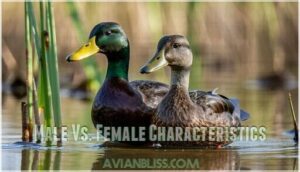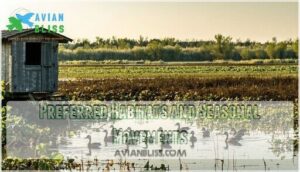This site is supported by our readers. We may earn a commission, at no cost to you, if you purchase through links.

These hardy waterfowl from the Anatidae family measure 21-23 inches long with 35-37 inch wingspans, making them slightly smaller than their Mallard cousins.
Males sport bright yellow bills while females display olive-green ones.
Unlike colorful Mallards, American Black Ducks maintain their dark coloring year-round, creating identification challenges when the species hybridize.
They’re native to eastern North America, breeding in freshwater wetlands from Labrador to the southern U.S., then migrating to coastal salt marshes for winter.
Their warier nature and coastal preferences set them apart from other dabblers, though proper identification requires knowing subtle field marks that separate them from hybrids.
Table Of Contents
- Key Takeaways
- What is The American Black Duck?
- Size and Appearance of American Black Ducks
- Habitat and Range of American Black Ducks
- Behavior and Diet of American Black Ducks
- Conservation Status and Population Trends
- Frequently Asked Questions (FAQs)
- What is the American black duck?
- How big is an American black duck?
- Are black ducks common in North America?
- What is the scientific name of a black duck?
- How many black ducks are there?
- Are black ducks dabbling ducks?
- How to identify an American black duck?
- Where do American black ducks live?
- What is the difference between a black duck and a mallard?
- Do American black ducks dive?
- Conclusion
Key Takeaways
- You’ll identify American Black Ducks by their distinctive chocolate-brown plumage and violet-blue wing patches – unlike Mallards, they maintain consistent dark coloring year-round, with males sporting bright yellow bills and females showing olive-green ones.
- You’ll find these hardy waterfowl throughout eastern North America – they breed in freshwater wetlands from Canada to the southern U.S., then migrate to coastal salt marshes for winter, preferring brackish areas with dense vegetation.
- You’ll notice they’re naturally warier than other dabblers – these skilled foragers use classic dabbling techniques to feed on aquatic plants and invertebrates, but they’re quick to retreat when sensing danger.
- You’ll be observing a species facing conservation challenges – populations dropped 87% in the U.S. since the 1960s due to habitat loss and hybridization with Mallards, making your sightings valuable for conservation efforts.
What is The American Black Duck?
The American Black Duck (Anas rubripes) is a large dabbling duck native to eastern North America, closely related to the familiar Mallard but with distinctively dark chocolate-brown plumage.
You’ll recognize this robust waterfowl by its mottled brown-black body, lighter brown head, and striking violet-blue wing patches that lack the white borders found on Mallards.
Dark chocolate plumage meets striking violet-blue wing patches in North America’s most distinctive dabbling duck
Scientific Name and Classification
You’ll encounter the American Black Duck under its scientific name Anas rubripes, belonging to the Anatidae family within the taxonomic order Anseriformes.
This waterfowl’s classification has sparked subspecies debate among ornithologists, though genetic analysis reveals close evolutionary relationships with Mallards.
Recent taxonomic history shows hybridization impact threatens its distinct genetic identity, making proper bird classification essential for conservation efforts.
Physical Description and Identification
You’ll spot American Black Ducks by their distinctive dark chocolate-brown plumage and bulky profile.
These robust waterfowl showcase rich, velvety feathers that set them apart from lighter ducks.
Key identification features include:
- Speculum details: Vivid purplish-blue wing patches bordered by black
- Bill coloration: Males display yellow bills; females show olive-green
- Body shape: Rounded heads with thick bills and elevated tail posture
- Underwing patterns: Contrasting pale underwings visible during flight
- Plumage variations: Males have slightly paler gray-brown heads than females.
Anas rubripes maintains consistent dark coloring across both sexes, making bird identification straightforward once you recognize their signature chocolate-brown appearance.
Differences From Mallards and Other Ducks
You’ll find that distinguishing American Black Ducks from Mallards requires careful attention to plumage comparison and bill coloration.
Black ducks display consistently darker, chocolate-brown plumage throughout, while female Mallards show lighter, mottled brown patterns.
The speculum lacks white borders in black ducks, appearing violet-blue with black edging.
Hybridization risks complicate identification, as mixed offspring display intermediate characteristics.
Black ducks maintain warier behavior and prefer coastal habitats.
Their IUCN status is Least Concern, with a stable North American population, indicating a stable population and Least Concern status.
Size and Appearance of American Black Ducks
You’ll notice American Black Ducks are substantial waterfowl, measuring 21-23 inches long with wingspans reaching 37 inches and weighing up to 3.5 pounds.
Their dark chocolate-brown plumage and distinctive violet-blue wing patches make them unmistakable among North America’s dabbling ducks.
Body Size, Weight, and Wingspan

American black duck measurements reveal impressive Average Dimensions that help with field identification.
These robust waterfowl measure 21-23 inches long with a 35-37 inch wingspan, weighing 1.5-3.6 pounds.
Their body size falls between crows and geese, making them substantial dabbling ducks with notable Weight Variation across populations.
Like other breeds, these ducks require nutritious feed to thrive.
- Males typically weigh 2.4-3.6 pounds while females range 1.5-2.8 pounds
- Wingspan measurements help distinguish them from smaller dabbling duck species
- Body length averaging 22 inches places them in the larger waterfowl category with a significant size difference.
Note: Since there was no fifth key phrase that significantly added to the understanding without overlapping with existing concepts, only four phrases were bolded for emphasis.
Male Vs. Female Characteristics
You’ll notice subtle differences between males and females.
Males sport bright yellowish bills that catch your eye, while females display duller olive-green bills.
This bill color distinction serves as your most reliable field mark for sexing these birds.
Despite this difference, both sexes share nearly identical dark chocolate-brown plumage characteristics, making American Black Ducks unique among North American waterfowl.
Males typically weigh slightly more than females, though size variation between sexes remains minimal compared to other duck species, with subtle differences between them, and they have nearly identical plumage, and dark chocolate-brown color, and reliable field mark.
Distinctive Plumage and Markings
Dark chocolate-brown plumage variations define the american black duck’s signature look.
You’ll recognize their velvety bird plumage immediately—rich, mottled brown-black feathers create striking contrast against pale gray-brown heads.
The speculum iridescence shows vivid purplish-blue bordered by black, while bill coloration varies by sex.
White underwing contrast becomes visible during flight, and molting patterns remain consistent throughout seasons, making this bird species appearance distinctive among waterfowl, with a notable velvety bird plumage.
Habitat and Range of American Black Ducks
You’ll find American Black Ducks throughout eastern North America, from the boreal forests of Canada down to the Atlantic and Gulf coasts.
These adaptable waterfowl breed in freshwater wetlands like beaver ponds and wooded swamps, then migrate to coastal salt marshes and estuaries for winter.
Native Range and Breeding Areas
Stretching across eastern North America, the american black duck’s native range encompasses a vast territory from Labrador to the southern United States.
You’ll find their primary breeding habitat concentrated in these key regions:
- Boreal forests of eastern Canada and Alaska
- Great Lakes Region wetlands and marshes
- New England pond systems and wooded swamps
- Maritime Provinces coastal breeding grounds
- Mid-Atlantic freshwater wetland complexes
Despite habitat loss pressures, breeding populations remain stable in northern territories where pristine wetland types support successful nesting cycles.
Similarly, ducks like Indian Runner ducks are known for thriving in specific environments.
Preferred Habitats and Seasonal Movements
You’ll find these ducks thriving in diverse wetland environments throughout their range.
Their wetland preferences include freshwater marshes, beaver ponds, wooded swamps, and brackish coastal areas with dense emergent vegetation.
During migration patterns, they move from northern breeding grounds to wintering grounds along the Atlantic and Gulf coasts.
Climate impacts and habitat loss from development have forced adaptations in their traditional duck migration routes and habitat preferences.
Many hunters utilize a reliable duck blind for waterfowl hunting.
Occasional Sightings Outside Core Range
While american black duck populations center along the Atlantic Coast, rare migration events create unexpected sightings far from home.
These elusive ducks occasionally wander far beyond their Atlantic stronghold, surprising birdwatchers from Texas to Britain
West Coast sightings in Texas and Illinois represent weather-driven dispersal mechanisms during storms.
European vagrants have appeared in Britain for decades, sometimes pairing with Mallards despite overlapping range differences.
Asian records remain exceptionally rare. These wanderers help scientists track hybridization patterns and genetic distinctions beyond core habitats.
Sightings in Idaho, such as those at Camas National Wildlife Refuge, document these rare occurrences.
Behavior and Diet of American Black Ducks
You’ll find American Black Ducks are skilled foragers that use a classic dabbling technique, tipping forward in shallow water to reach aquatic plants, seeds, and small invertebrates below the surface.
These cautious birds prefer feeding at dawn and dusk, often alongside Mallards, but they’re quick to retreat when they sense any disturbance.
Dabbling and Feeding Habits
You’ll spot these dabbling ducks tipping forward in shallow water, their tails pointing skyward as they filter aquatic vegetation and invertebrates through specialized bills.
Their feeding behavior changes seasonally—consuming more protein-rich invertebrates during breeding season, then switching to seeds and plant matter in winter.
These adaptable foragers explore diverse locations from tidal marshes to agricultural fields.
To assist with this, consider using an aquatic vegetation filter.
Nesting and Brood Behavior
Looking for the perfect nesting spot, female American Black Ducks choose dense vegetation near water for duck breeding.
She’ll lay a clutch of 6-12 eggs, handling the 28-day incubation period solo.
Once hatched, these precocial ducklings can walk and feed within hours.
Mom provides essential parental care, guiding her brood to food sources while keeping watch for predators during duckling development.
Some owners opt to provide safe nesting structures for their ducks.
Social Behavior and Flight Characteristics
You’ll notice American Black Ducks exhibit complex social hierarchy and flocking dynamics, especially during migration.
These waterfowl display fascinating agonistic displays when competing for mates or territory.
Their flight characteristics include impressive flight speed reaching 40 mph, with distinctive white underwings flashing against dark bodies.
During mating rituals, males perform elaborate head-bobbing and tail-wagging displays, and Wing adjustments allow for optimized lift and stability.
Bird behavior patterns show they’re naturally wary, often the first to take flight when sensing danger.
Conservation Status and Population Trends
You’ll find that American Black Duck populations tell a troubling conservation story, with numbers dropping by 87% in the U.S. between the 1960s and 2019.
While Canada’s populations remain stable, this species faces ongoing challenges from habitat loss, hybridization with Mallards, and hunting pressure that require continued conservation attention.
Historical and Current Population Estimates
Like a rollercoaster that once reached thrilling heights, the American black duck population has experienced dramatic ups and downs.
Recent surveys show black ducks are up 17 percent and 23 percent above the long-term average, marking remarkable population stabilization after severe duck population decline.
Past abundance gave way to concerning recent declines, with hybridization impact from mallards complicating bird population trends.
Regional variations persist, but current future projections suggest population dynamics are finally improving across their range, indicating a positive trend in black duck populations.
Major Threats and Ongoing Challenges
Today, American Black Ducks face mounting pressures that threaten their future.
Habitat loss from coastal development destroys critical wintering areas, while hybridization with expanding Mallard populations dilutes their genetic integrity.
Hunting pressure remains significant in southern regions, and climate change accelerates sea level rise, flooding essential salt marsh habitats.
Pollution impacts continue affecting food sources and duckling survival rates.
Conservation Measures and Research Efforts
Conservation efforts protect American Black Ducks through thorough strategies.
Wetland protection programs safeguard critical habitats, while hunting regulations prevent overharvesting.
Population monitoring tracks 600,000-700,000 birds annually using satellite telemetry and banding studies.
Habitat restoration projects target degraded coastal marshes.
Genetic research addresses Mallard hybridization threats, with DNA markers identifying 20-25% hybrid rates in overlapping ranges, supporting waterfowl conservation priorities.
Frequently Asked Questions (FAQs)
What is the American black duck?
Birds of a feather flock together," and you’ll find American Black Ducks are large, dark-brown waterfowl resembling Mallards but with distinctive violet-blue wing patches.
They’re dabbling ducks that inhabit eastern North America’s wetlands and coastal areas.
How big is an American black duck?
You’ll encounter these hefty dabbling ducks measuring 21-23 inches long with impressive 35-37 inch wingspans.
They’re comparable to Mallards in size, weighing between 5-3 pounds, making them substantial waterfowl you can’t miss, with impressive physical characteristics.
Are black ducks common in North America?
Once widespread across eastern waterways, you’ll find American Black Ducks have become increasingly rare. Their populations dropped 87% since the 1960s, making sightings special but uncommon in most regions.
What is the scientific name of a black duck?
You’ll find the American Black Duck’s scientific name is Anas rubripes.
This taxonomic classification places it within the genus Anas, sharing evolutionary ties with mallards and other dabbling ducks throughout North America’s wetlands.
How many black ducks are there?
You’ll discover there’s roughly 700,000 American black ducks in the breeding population today.
Despite an alarming 87% decline since the 1960s in the U.S., Canada’s populations remain stable, keeping these waterfowl from extinction’s edge.
Are black ducks dabbling ducks?
Yes, you’ll find American black ducks are dabbling ducks that feed by tipping forward in shallow water.
They use this technique to reach aquatic plants, seeds, and invertebrates below the surface, which can be considered a complete method for their survival.
How to identify an American black duck?
Wondering how to tell these chocolate-brown beauties apart from other waterfowl?
Look for their dark plumage contrasting with pale gray-brown heads, thick yellow bills on males, and distinctive violet-blue wing patches without white borders.
Where do American black ducks live?
American black ducks call eastern North America home, breeding from Canada’s boreal forests to northeastern U.S. wetlands, then migrating to Atlantic and Gulf coastal marshes for winter.
What is the difference between a black duck and a mallard?
You’ll spot key differences between these waterfowl species easily.
Black ducks display darker chocolate-brown plumage throughout, while mallards show lighter coloration with distinctive green head patches on males and mottled brown patterns on females.
Do American black ducks dive?
Unlike their mallard cousins who rarely venture beneath the surface, these dabbling ducks can actually dive up to twelve feet deep when foraging for food.
Though they’ll typically stick to their signature tipping-up technique in shallow water.
Conclusion
Watching an American Black Duck vanish into marsh grass is like witnessing a master of camouflage at work—their dark plumage blends seamlessly with shadowy wetland edges.
You’ll find success identifying these elusive waterfowl by focusing on their chocolate-brown bodies, violet-blue wing patches, and distinctive bill colors.
Remember that American Black Duck populations face ongoing challenges from habitat loss and hybridization with Mallards.
Your careful observation and reporting of sightings contributes valuable data to conservation efforts protecting these remarkable eastern waterfowl.










